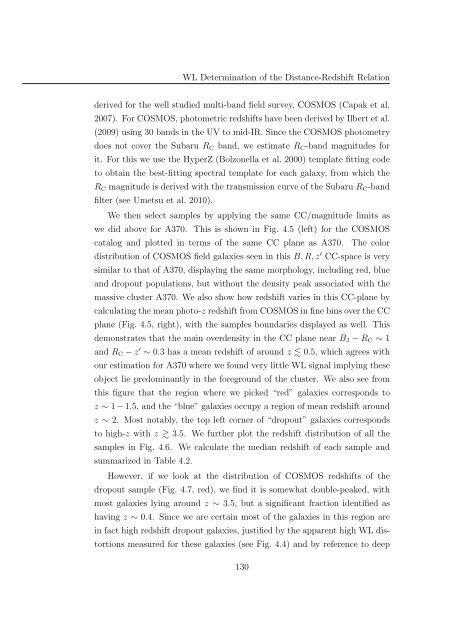Mass and Light distributions in Clusters of Galaxies - Henry A ...
Mass and Light distributions in Clusters of Galaxies - Henry A ...
Mass and Light distributions in Clusters of Galaxies - Henry A ...
Create successful ePaper yourself
Turn your PDF publications into a flip-book with our unique Google optimized e-Paper software.
WL Determ<strong>in</strong>ation <strong>of</strong> the Distance-Redshift Relation<br />
derived for the well studied multi-b<strong>and</strong> field survey, COSMOS (Capak et al.<br />
2007). For COSMOS, photometric redshifts have been derived by Ilbert et al.<br />
(2009) us<strong>in</strong>g 30 b<strong>and</strong>s <strong>in</strong> the UV to mid-IR. S<strong>in</strong>ce the COSMOS photometry<br />
does not cover the Subaru R C b<strong>and</strong>, we estimate R C -b<strong>and</strong> magnitudes for<br />
it. For this we use the HyperZ (Bolzonella et al. 2000) template fitt<strong>in</strong>g code<br />
to obta<strong>in</strong> the best-fitt<strong>in</strong>g spectral template for each galaxy, from which the<br />
R C magnitude is derived with the transmission curve <strong>of</strong> the Subaru R C -b<strong>and</strong><br />
filter (see Umetsu et al. 2010).<br />
We then select samples by apply<strong>in</strong>g the same CC/magnitude limits as<br />
we did above for A370. This is shown <strong>in</strong> Fig. 4.5 (left) for the COSMOS<br />
catalog <strong>and</strong> plotted <strong>in</strong> terms <strong>of</strong> the same CC plane as A370. The color<br />
distribution <strong>of</strong> COSMOS field galaxies seen <strong>in</strong> this B, R, z ′ CC-space is very<br />
similar to that <strong>of</strong> A370, display<strong>in</strong>g the same morphology, <strong>in</strong>clud<strong>in</strong>g red, blue<br />
<strong>and</strong> dropout populations, but without the density peak associated with the<br />
massive cluster A370. We also show how redshift varies <strong>in</strong> this CC-plane by<br />
calculat<strong>in</strong>g the mean photo-z redshift from COSMOS <strong>in</strong> f<strong>in</strong>e b<strong>in</strong>s over the CC<br />
plane (Fig. 4.5, right), with the samples boundaries displayed as well. This<br />
demonstrates that the ma<strong>in</strong> overdensity <strong>in</strong> the CC plane near B J − R C ∼ 1<br />
<strong>and</strong> R C − z ′ ∼ 0.3 has a mean redshift <strong>of</strong> around z 0.5, which agrees with<br />
our estimation for A370 where we found very little WL signal imply<strong>in</strong>g these<br />
object lie predom<strong>in</strong>antly <strong>in</strong> the foreground <strong>of</strong> the cluster. We also see from<br />
this figure that the region where we picked “red” galaxies corresponds to<br />
z ∼ 1 − 1.5, <strong>and</strong> the “blue” galaxies occupy a region <strong>of</strong> mean redshift around<br />
z ∼ 2. Most notably, the top left corner <strong>of</strong> “dropout” galaxies corresponds<br />
to high-z with z 3.5. We further plot the redshift distribution <strong>of</strong> all the<br />
samples <strong>in</strong> Fig. 4.6. We calculate the median redshift <strong>of</strong> each sample <strong>and</strong><br />
summarized <strong>in</strong> Table 4.2.<br />
However, if we look at the distribution <strong>of</strong> COSMOS redshifts <strong>of</strong> the<br />
dropout sample (Fig. 4.7, red), we f<strong>in</strong>d it is somewhat double-peaked, with<br />
most galaxies ly<strong>in</strong>g around z ∼ 3.5, but a significant fraction identified as<br />
hav<strong>in</strong>g z ∼ 0.4. S<strong>in</strong>ce we are certa<strong>in</strong> most <strong>of</strong> the galaxies <strong>in</strong> this region are<br />
<strong>in</strong> fact high redshift dropout galaxies, justified by the apparent high WL distortions<br />
measured for these galaxies (see Fig. 4.4) <strong>and</strong> by reference to deep<br />
130
















